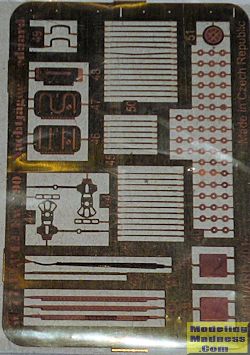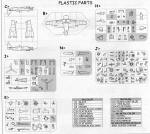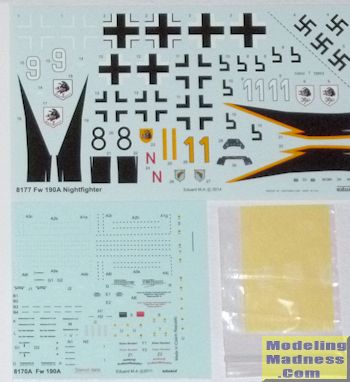
Eduard 1:48 Focke Wulf Fw 190 Nachtjäger
| KIT #: | 8177 |
| PRICE: | 4140 yen from Hobby Link Japan |
| DECALS: | Four options |
| REVIEWER: | Franciso Santoro |
| NOTES: |

| HISTORY |
Though flying for the first time before the outbreak of WWII, the little and
agile fighter was unobserved by the Allies, causing an ugly surprise when it
first entered in combat service over France in 1941. In fact, it was superior to
the bigger and slower Spitfire Mk V so, for the first time, the RAF was not only
surpassed in number, but also technically.
In June 1942, an Fw 190A-3 landed by mistake in England. Testing showed that the
Fw 190 was better than expected. It was faster and better armed than any other
Allied fighter in service, and had also heavier armament (in that time, its
armament consisted of two 7,92mm MG 17 on the engine cowling, two unknown Mauser
cannons and two external 20mm MG FF), it was very robust, it had excellent
manoeuvrability and a good field of view for the pilot.
It was also an small target, it was lighter than any other Allied fighter in
service, and it had a wide track landing gear (rather than the narrow track of
the Bf 109). Though it never replaced the Bf 109, it was manufactured in various
versions by different factories.
The Fw 190A series included several fighter and fighter-bomber versions, some
having not only its armament reinforced with heavier guns but also having strong
points under the wings to carry two/four 20mm cannons or two 30mm cannons. Most
of them had an MW 50 or GM-1 overpowering system (or had both).
Some Fw 190As carried torpedoes, others were dual trainers, some received an
automatic pilot for bad weather and night fighting.
It´s curious that the Bf 109, an older design with lots of
disadvanteges
would be produced in higher numbers, flown also by most of the Luftwaffe aces.
In 1945, the Fw 190A-5 was put in production in an underground facility in
France, directed by the SNCASO. 64 machines had been completed by 1946.
| THE KIT |
 Coming in a top opening box, the
Coming in a top opening box, the
 kit is molded in dark grey plastic, there were
no signs of flash or any molding defect that I could detect on the 213
pieces of the kit. It has fine panel lines and rivets.
kit is molded in dark grey plastic, there were
no signs of flash or any molding defect that I could detect on the 213
pieces of the kit. It has fine panel lines and rivets.
It comes with a complete engine, which can be seen by using the clear part for
the machinegun armament for the nose. 3 versions of the Fw 190 can be made, Fw
190A-6, Fw 190A-7 and Fw 190A-8, it comes with a coloured etched fret for the
cockpit parts and a second, golden etched fret for the antennaes.
The main decals are printed by Cartograf and the stencils are printed by Eduard.
There are four versions of the plane. It also has painting masks for the wheels
and canopy .
.
The four options for the plane are:
1)
Focke Wulf Fw 190A-6/R11 White 11, W.Nr. 550143, flown by Oblt. Fritz Krause, 1/NJGr
10, Werneuchen airfiel, Germany, January 1944. Painted in RLM 04/74/75/76.
2)
Focke Wulf Fw 190A-6/R11 “Neptun” Black 8, II/JG 300, Lobnitz, Fall of 1943.
3)
Focke Wulf Fw 190A-7/R11 “Neptun” Yellow 1/Red N, flown by Lt. Klaus
Bretschneider, 6/JG 300, Rheine, March 1944.
4) Focke Wulf Fw 190A-8/R11 “Neptun” White 9, flown by Ofw. Gunther Migge, 1/NJGr 10, Werneuchen airfield, 1944.
| CONCLUSIONS |
It looks to be an excellent kit, but at the same time it seems to be rather hard
to build, my guessings are that this kit might be suitable only for intermediate
to advanced modellers.
| REFERENCES |
March 2015
If you would like your product reviewed fairly and fairly quickly, please contact the editor or see other details in the Note to Contributors.